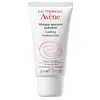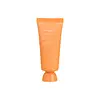What's inside
What's inside
 Key Ingredients
Key Ingredients

No key ingredients
 Benefits
Benefits

 Concerns
Concerns

 Ingredients Side-by-side
Ingredients Side-by-side

Water
Skin ConditioningParaffinum Liquidum
EmollientCaprylic/Capric Triglyceride
MaskingCarthamus Tinctorius Seed Oil
MaskingPalmitic Acid
EmollientStearic Acid
CleansingHydrogenated Palm/Palm Kernel Oil PEG-6 Esters
EmollientTriethanolamine
BufferingGlyceryl Stearate
EmollientMicrocrystalline Wax
Emulsion StabilisingPEG-100 Stearate
Propylene Glycol
Humectant1,2-Hexanediol
Skin ConditioningCaprylic/Capric Glycerides
EmollientCaprylyl Glycol
EmollientCarbomer
Emulsion StabilisingDisodium EDTA
Parfum
MaskingPhenyl Trimethicone
Skin ConditioningRibes Rubrum Fruit Extract
TonicRubus Idaeus Fruit Extract
AstringentSodium Benzoate
MaskingTocopheryl Glucoside
EmollientTropolone
Skin ConditioningVaccinium Myrtillus Fruit Extract
Skin ConditioningWater, Paraffinum Liquidum, Caprylic/Capric Triglyceride, Carthamus Tinctorius Seed Oil, Palmitic Acid, Stearic Acid, Hydrogenated Palm/Palm Kernel Oil PEG-6 Esters, Triethanolamine, Glyceryl Stearate, Microcrystalline Wax, PEG-100 Stearate, Propylene Glycol, 1,2-Hexanediol, Caprylic/Capric Glycerides, Caprylyl Glycol, Carbomer, Disodium EDTA, Parfum, Phenyl Trimethicone, Ribes Rubrum Fruit Extract, Rubus Idaeus Fruit Extract, Sodium Benzoate, Tocopheryl Glucoside, Tropolone, Vaccinium Myrtillus Fruit Extract
Water
Skin ConditioningButylene Glycol
HumectantGlycerin
HumectantCetyl Ethylhexanoate
Emollient1,2-Hexanediol
Skin ConditioningSqualane
EmollientButyrospermum Parkii Butter
Skin ConditioningDi-C12-13 Alkyl Malate
EmollientCyclopentasiloxane
EmollientDimethicone
EmollientGlyceryl Stearate
EmollientCyclohexasiloxane
EmollientTrehalose
HumectantC14-22 Alcohols
Emulsion StabilisingPalmitic Acid
EmollientStearic Acid
CleansingCetearyl Alcohol
EmollientHydrogenated Castor Oil Isostearate
Skin ConditioningHydroxypropyl Starch Phosphate
PEG-100 Stearate
Dimethicone/Vinyl Dimethicone Crosspolymer
Skin ConditioningC12-20 Alkyl Glucoside
EmulsifyingPolyacrylate-13
Phytosteryl/Behenyl/Octyldodecyl Lauroyl Glutamate
Skin ConditioningC12-16 Alcohols
EmollientAcrylates/C10-30 Alkyl Acrylate Crosspolymer
Emulsion StabilisingTromethamine
BufferingParfum
MaskingXanthan Gum
EmulsifyingZiziphus Jujuba Fruit Extract
Skin ConditioningGlyceryl Caprylate
EmollientJuglans Regia Seed Extract
Skin ConditioningLimonene
PerfumingPolyisobutene
Scutellaria Baicalensis Root Extract
AstringentHydrogenated Lecithin
EmulsifyingMorus Alba Root Extract
BleachingDisodium EDTA
Ethylhexylglycerin
Skin ConditioningDextrin
AbsorbentTheobroma Cacao Extract
Skin ConditioningHoney
HumectantLinalool
PerfumingPolysorbate 20
EmulsifyingNelumbo Nucifera Flower Extract
Skin ConditioningPolygonatum Officinale Rhizome/Root Extract
Skin ConditioningRehmannia Glutinosa Root Extract
Skin ConditioningPaeonia Albiflora Root Extract
Skin ConditioningLilium Candidum Bulb Extract
Skin ConditioningSorbitan Isostearate
EmulsifyingPanax Ginseng Root Extract
EmollientPunica Granatum Fruit Extract
AntioxidantPropanediol
SolventCitronellol
PerfumingCitral
PerfumingGeraniol
PerfumingMyristic Acid
CleansingArachidic Acid
CleansingGlucose
HumectantBenzyl Benzoate
AntimicrobialGlycyrrhiza Uralensis Root Extract
Skin ConditioningTocopherol
AntioxidantPunica Granatum Flower Extract
Skin ConditioningWater, Butylene Glycol, Glycerin, Cetyl Ethylhexanoate, 1,2-Hexanediol, Squalane, Butyrospermum Parkii Butter, Di-C12-13 Alkyl Malate, Cyclopentasiloxane, Dimethicone, Glyceryl Stearate, Cyclohexasiloxane, Trehalose, C14-22 Alcohols, Palmitic Acid, Stearic Acid, Cetearyl Alcohol, Hydrogenated Castor Oil Isostearate, Hydroxypropyl Starch Phosphate, PEG-100 Stearate, Dimethicone/Vinyl Dimethicone Crosspolymer, C12-20 Alkyl Glucoside, Polyacrylate-13, Phytosteryl/Behenyl/Octyldodecyl Lauroyl Glutamate, C12-16 Alcohols, Acrylates/C10-30 Alkyl Acrylate Crosspolymer, Tromethamine, Parfum, Xanthan Gum, Ziziphus Jujuba Fruit Extract, Glyceryl Caprylate, Juglans Regia Seed Extract, Limonene, Polyisobutene, Scutellaria Baicalensis Root Extract, Hydrogenated Lecithin, Morus Alba Root Extract, Disodium EDTA, Ethylhexylglycerin, Dextrin, Theobroma Cacao Extract, Honey, Linalool, Polysorbate 20, Nelumbo Nucifera Flower Extract, Polygonatum Officinale Rhizome/Root Extract, Rehmannia Glutinosa Root Extract, Paeonia Albiflora Root Extract, Lilium Candidum Bulb Extract, Sorbitan Isostearate, Panax Ginseng Root Extract, Punica Granatum Fruit Extract, Propanediol, Citronellol, Citral, Geraniol, Myristic Acid, Arachidic Acid, Glucose, Benzyl Benzoate, Glycyrrhiza Uralensis Root Extract, Tocopherol, Punica Granatum Flower Extract
Ingredients Explained
These ingredients are found in both products.
Ingredients higher up in an ingredient list are typically present in a larger amount.
1,2-Hexanediol is a synthetic liquid and another multi-functional powerhouse.
It is a:
- Humectant, drawing moisture into the skin
- Emollient, helping to soften skin
- Solvent, dispersing and stabilizing formulas
- Preservative booster, enhancing the antimicrobial activity of other preservatives
Disodium EDTA plays a role in making products more stable by aiding other preservatives.
It is a chelating agent, meaning it neutralizes metal ions that may be found in a product.
Disodium EDTA is a salt of edetic acid and is found to be safe in cosmetic ingredients.
Learn more about Disodium EDTAGlyceryl Stearate is a mix of glycerin and stearic acid.
It is used to stabilize the mixing of water and oil ingredients. By preventing these ingredients from separating, it can help elongate shelf life. It can also help thicken the product's texture.
As an emollient, it helps soften skin and supports barrier-replenishing ingredients.
In cosmetics, Glyceryl Stearate is often made from vegetable oils or synthetically produced.
This ingredient may not be fungal-acne safe
Fun fact: The human body also creates Glyceryl Stearate naturally.
Learn more about Glyceryl StearatePalmitic Acid is a fatty acid naturally found in our skin and in many plant and animal sources. In cosmetics, it is usually derived from palm oil. It serves many purposes in skincare, acting as a cleanser, emollient, and emulsifier.
As an emollient, palmitic acid helps soften and smooth the skin by preventing water loss. In cleansers, it helps remove oil and dirt while creating foam.
Its emulsifying properties help stabilize products by keeping water and oil-based ingredients from separating.
This may not be suitable for fungal acne-prone skin, as fatty acids like this can sometimes trigger breakouts in sensitive individuals.
Learn more about Palmitic AcidParfum is a catch-all term for an ingredient or more that is used to give a scent to products.
Also called "fragrance", this ingredient can be a blend of hundreds of chemicals or plant oils. This means every product with "fragrance" or "parfum" in the ingredients list is a different mixture.
For instance, Habanolide is a proprietary trade name for a specific aroma chemical. When used as a fragrance ingredient in cosmetics, most aroma chemicals fall under the broad labeling category of “FRAGRANCE” or “PARFUM” according to EU and US regulations.
The term 'parfum' or 'fragrance' is not regulated in many countries. In many cases, it is up to the brand to define this term.
For instance, many brands choose to label themselves as "fragrance-free" because they are not using synthetic fragrances. However, their products may still contain ingredients such as essential oils that are considered a fragrance by INCI standards.
One example is Calendula flower extract. Calendula is an essential oil that still imparts a scent or 'fragrance'.
Depending on the blend, the ingredients in the mixture can cause allergies and sensitivities on the skin. Some ingredients that are known EU allergens include linalool and citronellol.
Parfum can also be used to mask or cover an unpleasant scent.
The bottom line is: not all fragrances/parfum/ingredients are created equally. If you are worried about fragrances, we recommend taking a closer look at an ingredient. And of course, we always recommend speaking with a professional.
Learn more about ParfumPeg-100 Stearate is an emollient and emulsifier. As an emollient, it helps keep skin soft by trapping moisture in. On the other hand, emulsifiers help prevent oil and water from separating in a product.
PEGS are a hydrophilic polyether compound . There are 100 ethylene oxide monomers in Peg-100 Stearate. Peg-100 Stearate is polyethylene glycol ester of stearic acid.
Stearic Acid is a fatty acid. It is an emollient, emulsifier, and texture enhancer.
As an emollient, stearic acid helps soften skin. It aids the skin's protective barrier by preventing water loss. It also provides a gentle cleansing effect without stripping away natural oils.
Stearic acid may also be used to enhance the texture of products. It can add volume and stabilize ingredients such as water and oil. This can help water and oil ingredients from separating.
Sources of stearic acid include animal or vegetable fats/oils such as coconut or shea. It can be naturally found in butter, cocoa butter, shea butter, vegetable fats, and animal tallow.
This ingredient may not be Malassezia folliculitis, or fungal-acne safe.
Learn more about Stearic AcidWater. It's the most common cosmetic ingredient of all. You'll usually see it at the top of ingredient lists, meaning that it makes up the largest part of the product.
So why is it so popular? Water most often acts as a solvent - this means that it helps dissolve other ingredients into the formulation.
You'll also recognize water as that liquid we all need to stay alive. If you see this, drink a glass of water. Stay hydrated!
Learn more about Water